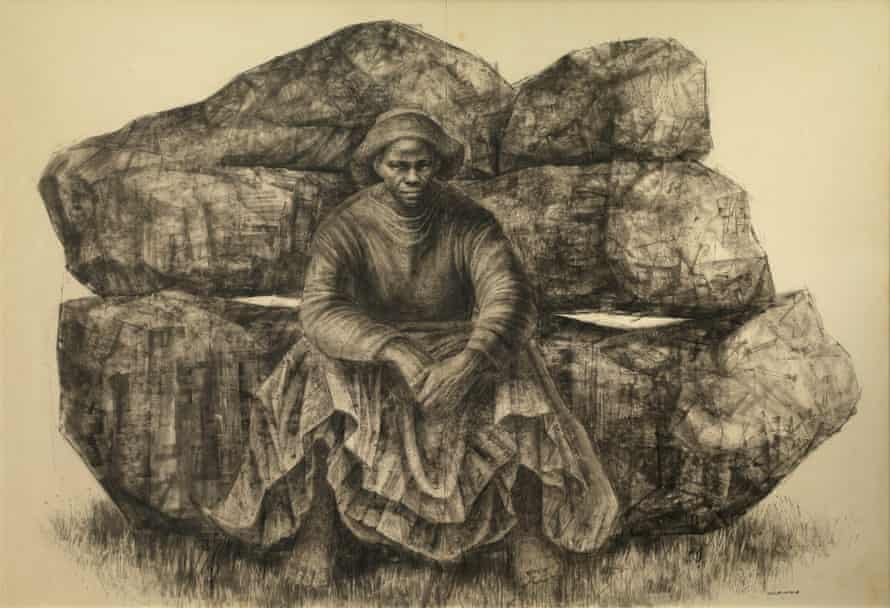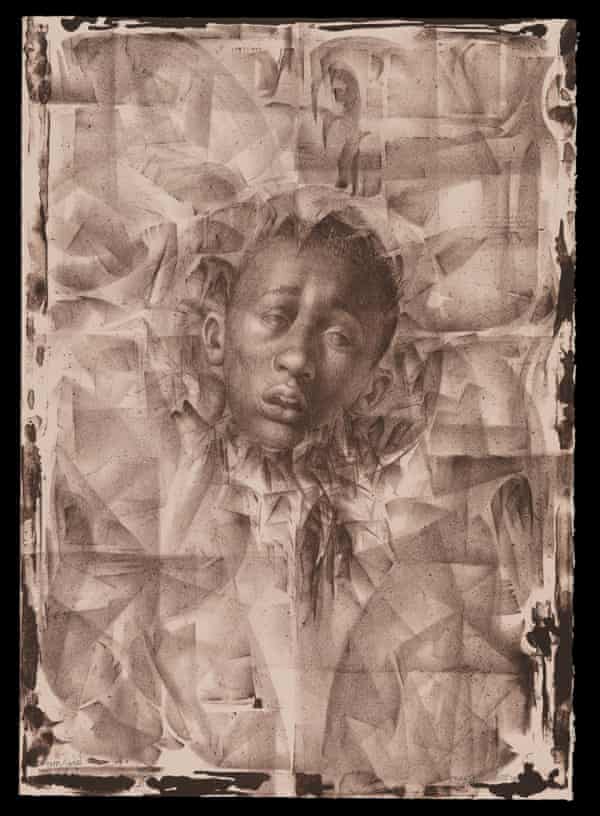Black and White Art of a View in Theworld
I due north the 1930s, African American creative person Charles White, a teenager in Chicago, raised his mitt in high schoolhouse. He stood upwards to his white teacher and asked why black history wasn't in the school curriculum, curious every bit to why figures like Denmark Vesey, Nat Turner and Frederick Douglass were being ignored. It got him scoffed at, ridiculed and accounted an embarrassment by his swain black classmates.
"When I spoke up near these ignored great figures," he said, "I would exist told to sit downwards and shut up."
This Chicago Blackness Renaissance artist, who worked through to the 1970s, tasked himself with shining a lite on the everyday lives of African Americans as well as underexamined bug of social justice, civil rights and dignity.
3 exhibitions in Los Angeles are now celebrating the artist's legacy – Charles White: A Retrospective is on view at the Los Angeles County Museum of Art until 9 June, showcasing 100 of his portrait drawings, prints and paintings. Life Model: Charles White and His Students traces the creative person'due south influence as the first black faculty member at the Otis Art Found, which is on view at the Charles White elementary school until 15 September. Plumb Line: Charles White and the Contemporary opens at the California African American Museum, showing roughly twoscore blackness artists who honor the artist in their ain mode, opening on 8 March.
"Charles White is ubiquitous in blackness art considering of the work he did," said Essence Harden, the co-curator of the CAAM exhibit. "The world looked unlike for him; it but did for black artists. His influence was so profound. He'southward everywhere and that'due south one of the most wonderful things about Charles White."
White was born in 1918 to a male parent who was Creek Indian, employed as a railroad worker, and his mother, a domestic worker from Mississippi. His grandmother was the daughter of a slave who had an affair with her white master. "I am not proud of this one white man who was one of my great-grandfathers," White said. "A typical slave master, he did non regard the product of his seduction of a slave as his offspring. She was merely another slave chattel."
White fabricated fine art as a child growing up on the South Side of Chicago, his passion was painting. After being deemed a rebel by his teachers, for asking questions such as the one he posed in the before chestnut, he dropped out of loftier school. White would go on to exist awarded various scholarships that were and so taken away when his race was discovered and was admitted to two art schools, both of which pulled his acceptance for the same reason. He was ultimately accepted to the Art Institute of Chicago, working as a cook and then equally an art instructor to pay for his materials, and was later jailed for forming a wedlock with other black artists to fight for equal wages. White worked to paint portraits of under-painted celebrated figures similar Sojourner Truth, Booker T Washington, Harriet Tubman and Frederick Douglass throughout the 1950s.

It was going against the grain of what he saw growing up. "It was in the books, equally well every bit in the motion pictures, cartoons, newspapers, 'jokes' and advertisements," said White. "The Negro people were portrayed equally grotesque stereotypes."
He was an encyclopedia of black history, eager to share his thirst for noesis with the public. He painted one mural, Five Not bad American Negroes – which depicts Sojourner Truth, Frederick Douglass, Booker T Washington, George Washington Carver and Marian Anderson – equally part of a fundraiser for Chicago's South Side Community Art Eye, when he was but 21 years quondam.
His nigh notable mural remains The Contribution of the Negro to American Democracy, featuring historic black figures like Nat Turner, a 19th-century slave who led a rebellion, Anderson, an opera vocaliser who performed at the Lincoln Memorial in 1939, and Peter Salem, a soldier who served in the American Revolutionary war of the 18th century.
Sarah Kelly Oehler, co-curator of the Lacma exhibit said White looked to the by to reflect on the present. "He returned to the past again and once again for aesthetic inspiration," she said, "to educate his fellow citizens and promote social equality by producing and displaying inspiring images of historical figures."
White may be known for his black portraits, but that's not where his fine art ends. "His practice included portraiture, a celebration of everyday black life, his engagement with political urgencies and his move towards abstraction at the end of his career," said Leigh Raiford, the co-curator of the CAAM exhibit.

He was too an enthusiastic purveyor of pop culture. From portraits of Harry Belafonte to album covers for the jazz label Vanguard Records (including a Grammy-nominated album cover for composer Morton Gould), White painted historic gospel singers like Mahalia Jackson, Paul Robeson and Bessie Smith, and had his fine art published on the cover of Life magazine.
He lived in New Orleans, briefly served in the ground forces, traveled through Europe in the 1950s and painted the political activist Angela Davis equally a plea and protestation later her arrest in 1970 as part of the Gratis Angela Davis and All Political Prisoners campaign.
The Lacma retrospective, a traveling exhibition co-organized by the Fine art Institute of Chicago and the Museum of Modernistic Fine art, traces his path every bit a civil rights activist in New York and LA, while the Life Model exhibit features the works of his former students, including Kerry James Marshall, whose $21.1m sale of his 1997 painting Past Times was a tape high for a blackness artist. Marshall recalls that despite having a scholarship from another school, he paid to report with White.
The Plumb Line exhibit looks at the immature blackness artists continuing White's legacy, including Sadie Barnette, Greg Breda and Toyin Ojih Odutola. They are shown alongside the drawings of the LA artist Lava Thomas'southward serial Women of the Montgomery Bus Boycott, mugshots of black women prosecuted afterwards protesting against racial segregation on the Alabama city's public ship in the 1950s. Thomas calls the serial "in dialogue with the current political and social climate of the country; the resurgence of white nationalism, the rise of racial hostility and lethal violence".
"Lava's work speaks to White'due south contention that fine art should be political and accost questions of liberation and freedom," said Raiford of Thomas's work. "They're historical figures who haven't gotten the attention they deserve for their participation in the advancement of blackness social movements."
Also on view are Breda's portraits based on Depression-era photographs, 1 titled Untitled (Salt, Woman westward/ big hat') from 2013.
"He made that slice in tribute to the Great Low of the 1930s, the rural blackness folks and the summit of black labor," said Raiford. "Images of dignity are really a cornerstone for us, a vision of what we're subsequently."
Source: https://www.theguardian.com/artanddesign/2019/mar/01/the-world-looked-different-to-him-charles-whites-black-america
0 Response to "Black and White Art of a View in Theworld"
Post a Comment